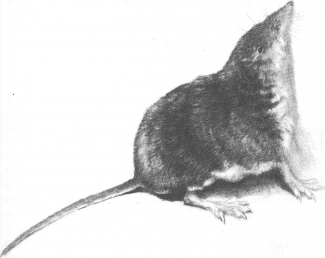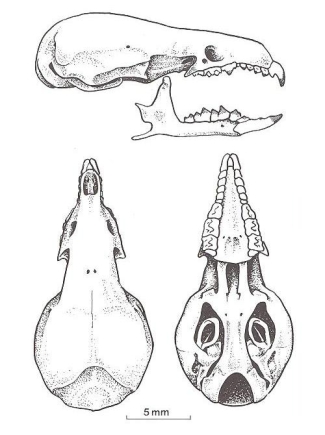In western North America, the breeding season extends from December to September. Male Water Shrews appear to begin breeding earlier than males of other species. Males with enlarged testes have been reported as early as December, and pregnant females have been found in February. Males do not breed in their first summer. Young males probably reach sexual maturity in December, whereas old males are not sexually active until February. In British Columbia, pregnant females have been found from May to early September. Six embryos are most common, but embryo counts can range from three to ten. Two or three litters may be produced in a breeding season.
|
The Water Shrew feeds primarily on aquatic insects. The major prey are the larvae of craneflies and caddisflies, and the nymphs of stoneflies and mayflies. Other invertebrates eaten are spiders, snails, slugs and adult flies. A Water Shrew was observed capturing a Pacific Giant Salamander larva. There are several reports of this species eating small fish (six to eight centimetres in length), such as sculpins, Common Shiners and salmon parr, and juvenile fish in provincial fish hatcheries. Despite its tendency to feed on aquatic animals, the Water Shrew is an opportunistic hunter with a flexible diet. In terrestrial environments, such as Tamarack bogs, the bulk of its diet is made up of carabid beetles, moth and butterfly larvae, and the pupae and larvae of sawflies. Captive animals will readily consume dead small mammals.
The Water Shrew captures much of its food underwater, then carries the prey to a rock or stream bank before eating. Snail shells are torn apart with the teeth to extract the soft body parts. A Water Shrew, observed hunting in a small pool, sat on a rock watching for Common Shiners passing nearby. The shrew dove in and attacked a minnow in its belly area with a series of swift bites, then carried it back to the rock and consumed the head and viscera.
The feeding behaviour of several captive Water Shrews has been studied. Feeding periods were brief, lasting only thirty to ninety seconds, and in intervals of about ten minutes, although Water Shrews can survive up to three hours without food. The captive shrews stored small fish, suet, oatmeal and insects in the cage for later consumption, hoarding insects in a hollow log and either burying the fish or storing them in hollow logs. Each shrew consumed or stored an average of 14.6 grams of food per day.
|
Home ranges of 0.2 and 0.3 hectares were reported for two individuals, but the movements of the species have not been well documented. No estimates exist for population numbers. But in most small-mammal trapping studies the Water Shrew represented a small proportion of the total captures, and it appears that this is one of the rarer shrews, even in ideal habitat. In British Columbia, the dominant shrew in communities with Water Shrews is usually the Dusky Shrew or the Common Shrew.
Although the Water Shrew is active at all hours, it has two peaks of activity, one just before dawn and the other just after dusk. It readily dives into water and can remain submerged for short periods, from a few to 20 seconds; shrews in captivity can tolerate forced dives of up to 48 seconds. The Water Shrew propels itself in water by paddling with the feet. Air bubbles trapped in the fur create an important layer of insulation and give the shrew a silvery appearance under water. Air bubbles trapped in the stiff hairs of the hind feet provide some buoyancy enabling this species to walk briefly on the surface of water. Immediately after a swim, the shrew shakes off the water and vigorously grooms its fur with its hind feet.
The Water Shrew's senses are not well understood. It is generally assumed that touch, particularly with the sensitive nose and vibrissae, is used to locate aquatic insects and snails on stream bottoms. Nevertheless, the role of the vibrissae as feelers is not clear. Captive shrews that had their vibrissae clipped were still able to locate food. Sight is probably poorly developed, although vision is used to detect swimming prey such as fish. Captive Water Shrews were able to hear sounds up to three metres away. While moving or exploring their cage, they emitted a series of continuous and rapid squeaks. Water Shrews may use high-frequency sounds (25 to 60 kilohertz) for echolocation. How effective these sounds would be in the vicinity of cascading water is not clear. The Water Shrew's sense of smell is well developed, and it produces a particularly strong musky odour.
Captive Water Shrews constructed nests from dried vegetation and shredded cloth. They made a depression with their feet and legs, and formed the walls of the nest with their muzzles. Most nests were about eight centimetres in diameter and were located under logs or in cavities in hollow logs. In the wild, a nest constructed from leaves and sticks was found just above the water line in a Beaver lodge. Captive animals used tunnels constructed by other small mammals, but were capable of digging their own tunnels with their front feet.
Captive Water Shrews are aggressive, and fighting is common. When two meet, they emit squeaking sounds and often rise up on their hind legs, displaying their light-coloured bellies. Fights are short but intense. The combatants slash each other with their teeth and usually clinch in a tight ball. They often injure their heads and tails in these fights. There is no evidence that the fighting is territorial: these shrews have not been observed defending food caches or nests.
The maximum life span for this species is about 18 months. Predators of the Water Shrew include snakes, large frogs, owls and fish.
|
|



